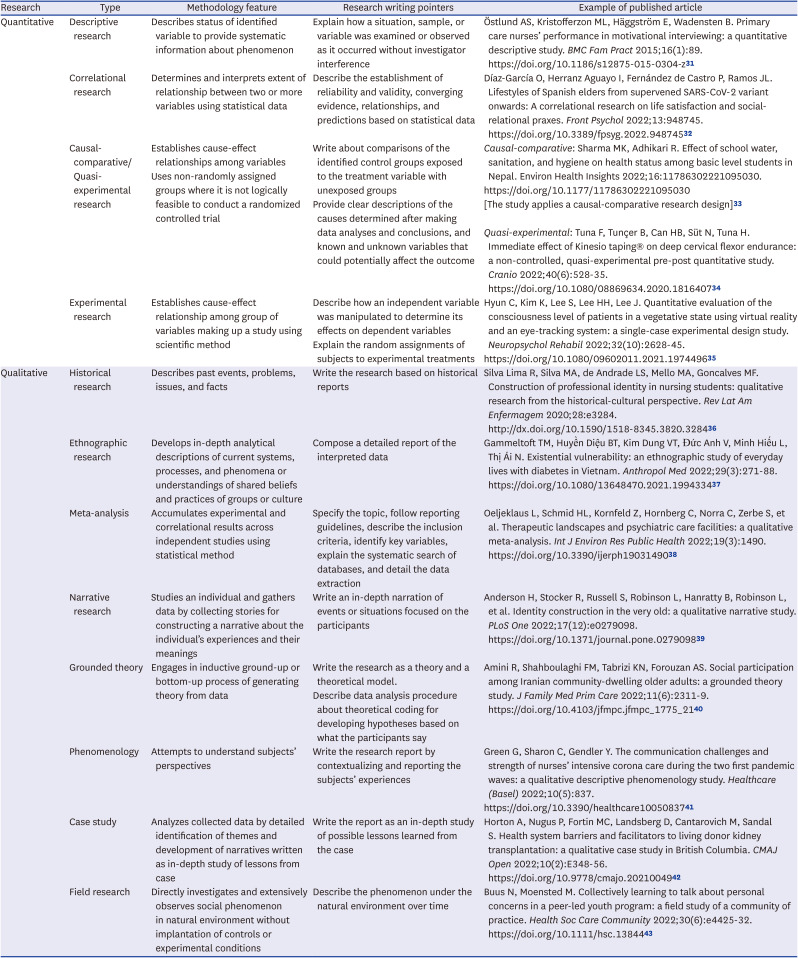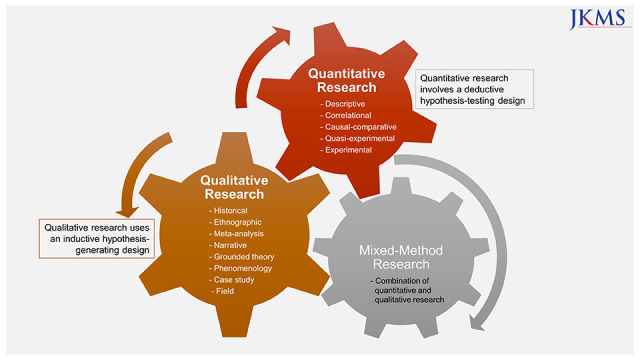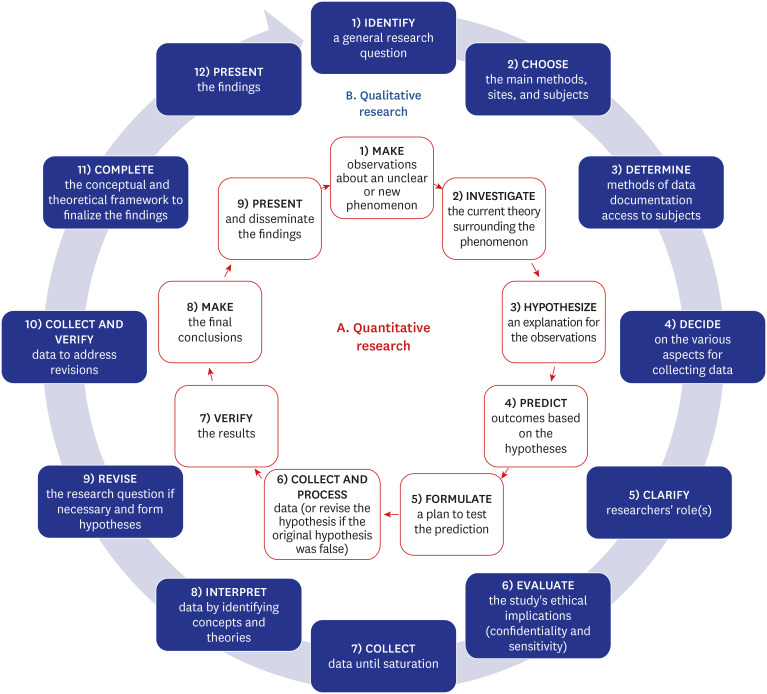2. Chigbu UE. Visually hypothesising in scientific paper writing: Confirming and refuting qualitative research hypotheses using diagrams. Publications. 2019; 7(1):22.

3. Gasparyan AY, Ayvazyan L, Mukanova U, Yessirkepov M, Kitas GD. Scientific hypotheses: writing, promoting, and predicting implications. J Korean Med Sci. 2019; 34(45):e300. PMID:
31760713.

4. Young M, Varpio L, Uijtdehaage S, Paradis E. The spectrum of inductive and deductive research approaches using quantitative and qualitative data. Acad Med. 2020; 95(7):1122. PMID:
31833855.

5. Barroga E, Matanguihan GJ. Correcting language mistakes in qualitative research articles. Cent Asian J Med Hypotheses Ethics. 2020; 1(2):146–151.

7. Gasparyan AY, Ayvazyan L, Blackmore H, Kitas GD. Writing a narrative biomedical review: considerations for authors, peer reviewers, and editors. Rheumatol Int. 2011; 31(11):1409–1417. PMID:
21800117.

8. Hong ST. Ten tips for authors of scientific articles. J Korean Med Sci. 2014; 29(8):1035–1037. PMID:
25120310.

9. Gu X, Xu Z. Sustainable development of EFL learners’ research writing competence and their identity construction: Chinese novice writer-researchers’ metadiscourse use in English research articles. Sustainability (Basel). 2021; 13(17):9523.

10. Elnathan R. English is the language of science - but precision is tough as a non-native speaker. Nature. Forthcoming. 2021; DOI: . DOI:
10.1038/d41586-021-00899-y.

11. Yakhontova T. English writing of non-Anglophone researchers. J Korean Med Sci. 2020; 35(26):e216. PMID:
32627440.

12. Shpit EI, McCarthy PM. Addressing discourse differences in the writing of Russian engineering students and international researchers. Lang Teach Res. Forthcoming. 2022; DOI: . DOI:
10.1177/13621688221109809.
13. Aspers P, Corte U. What is qualitative in qualitative research? Qual Sociol. 2019; 42(2):139–160. PMID:
31105362.

14. Munthe-Kaas HM, Glenton C, Booth A, Noyes J, Lewin S. Systematic mapping of existing tools to appraise methodological strengths and limitations of qualitative research: first stage in the development of the CAMELOT tool. BMC Med Res Methodol. 2019; 19(1):113. PMID:
31164084.

15. Noyes J, Booth A, Moore G, Flemming K, Tunçalp Ö, Shakibazadeh E. Synthesising quantitative and qualitative evidence to inform guidelines on complex interventions: clarifying the purposes, designs and outlining some methods. BMJ Glob Health. 2019; 4(Suppl 1):e000893.

16. Ryba TV, Wiltshire G, North J, Ronkainen NJ. Developing mixed methods research in sport and exercise psychology: potential contributions of a critical realist perspective. Int J Sport Exerc Psychol. 2022; 20(1):147–167.

17. Das AK, Datta B. Open science in addressing responsible research and innovation: Evidence from India and other countries. J Scientometr Res. 2020; 9(2s):s14–s23.

18. Christensen MV, Nieminen M, Altenhofer M, Tancoigne E, Mejlgaard N, Griessler E, et al. What’s in a name? Perceptions and promotion of responsible research and innovation practices across Europe. Sci Public Policy. 2020; 47(3):360–370.

19. Resnik DB. International standards for research integrity: An idea whose time has come? Account Res. 2009; 16(4):218–228. PMID:
20183162.

20. Cutri J, Freya A, Karlina Y, Patel SV, Moharami M, Zeng S, et al. Academic integrity at doctoral level: the influence of the imposter phenomenon and cultural differences on academic writing. IJEI. 2021; 17(1):8.
22. Misra DP, Gasparyan AY, Zimba O, Yessirkepov M, Agarwal V, Kitas GD. Formulating hypotheses for different study designs. J Korean Med Sci. 2021; 36(50):e338. PMID:
34962112.

24. Borgstede M, Scholz M. Quantitative and qualitative Approaches to generalization and replication: a representationalist view. Front Psychol. 2021; 12:605191. PMID:
33613387.

25. Das MK. An Introduction to qualitative and mixed methods study designs in Health. Indian Pediatr. 2022; 59(5):416–423. PMID:
34338218.

26. Bhangu S, Provost F, Caduff C. Introduction to qualitative research methods - Part I. Perspect Clin Res. 2023; 14(1):39–42. PMID:
36909216.

27. Chai HH, Gao SS, Chen KJ, Duangthip D, Lo EC, Chu CH. A concise review on qualitative research in dentistry. Int J Environ Res Public Health. 2021; 18(3):942. PMID:
33499023.

28. Baghlaf K. Necessity and relevance of qualitative research in pediatric dentistry. A literature review. Saudi Dent J. 2023; 35(1):31–38. PMID:
36817030.

29. Busetto L, Wick W, Gumbinger C. How to use and assess qualitative research methods. Neurol Res Pract. 2020; 2(1):14. PMID:
33324920.

30. Finn GM, Dueñas AN, Kehoe A, Brown ME. A novice’s guide to qualitative health professions education research. Clin Exp Dermatol. 2022; 47(12):2090–2095. PMID:
35978555.

31. Östlund AS, Kristofferzon ML, Häggström E, Wadensten B. Primary care nurses’ performance in motivational interviewing: a quantitative descriptive study. BMC Fam Pract. 2015; 16(1):89. PMID:
26205692.

32. Díaz-García O, Herranz Aguayo I, Fernández de Castro P, Ramos JL. Lifestyles of Spanish elders from supervened SARS-CoV-2 variant onwards: A correlational research on life satisfaction and social-relational praxes. Front Psychol. 2022; 13:948745. PMID:
36248522.

33. Sharma MK, Adhikari R. Effect of school water, sanitation, and hygiene on health status among basic level students in Nepal. Environ Health Insights. 2022; 16:11786302221095030. PMID:
35495174.

34. Tuna F, Tunçer B, Can HB, Süt N, Tuna H. Immediate effect of Kinesio taping® on deep cervical flexor endurance: a non-controlled, quasi-experimental pre-post quantitative study. Cranio. 2022; 40(6):528–535. PMID:
32883188.

35. Hyun C, Kim K, Lee S, Lee HH, Lee J. Quantitative evaluation of the consciousness level of patients in a vegetative state using virtual reality and an eye-tracking system: a single-case experimental design study. Neuropsychol Rehabil. 2022; 32(10):2628–2645. PMID:
34486951.

36. Silva Lima R, Silva MA, de Andrade LS, Mello MA, Goncalves MF. Construction of professional identity in nursing students: qualitative research from the historical-cultural perspective. Rev Lat Am Enfermagem. 2020; 28:e3284. PMID:
32520240.

37. Gammeltoft TM, Huyền Diệu BT, Kim Dung VT, Đức Anh V, Minh Hiếu L, Thị Ái N. Existential vulnerability: an ethnographic study of everyday lives with diabetes in Vietnam. Anthropol Med. 2022; 29(3):271–288. PMID:
34844468.

38. Oeljeklaus L, Schmid HL, Kornfeld Z, Hornberg C, Norra C, Zerbe S, et al. Therapeutic landscapes and psychiatric care facilities: a qualitative meta-analysis. Int J Environ Res Public Health. 2022; 19(3):1490. PMID:
35162518.

39. Anderson H, Stocker R, Russell S, Robinson L, Hanratty B, Robinson L, et al. Identity construction in the very old: a qualitative narrative study. PLoS One. 2022; 17(12):e0279098. PMID:
36520876.

40. Amini R, Shahboulaghi FM, Tabrizi KN, Forouzan AS. Social participation among Iranian community-dwelling older adults: a grounded theory study. J Family Med Prim Care. 2022; 11(6):2311–2319. PMID:
36119239.

41. Green G, Sharon C, Gendler Y. The communication challenges and strength of nurses’ intensive corona care during the two first pandemic waves: a qualitative descriptive phenomenology study. Healthcare (Basel). 2022; 10(5):837. PMID:
35627974.

42. Horton A, Nugus P, Fortin MC, Landsberg D, Cantarovich M, Sandal S. Health system barriers and facilitators to living donor kidney transplantation: a qualitative case study in British Columbia. CMAJ Open. 2022; 10(2):E348–E356.

43. Buus N, Moensted M. Collectively learning to talk about personal concerns in a peer-led youth program: a field study of a community of practice. Health Soc Care Community. 2022; 30(6):e4425–e4432. PMID:
35608005.

44. Pyo J, Lee W, Choi EY, Jang SG, Ock M. Qualitative research in healthcare: necessity and characteristics. J Prev Med Public Health. 2023; 56(1):12–20. PMID:
36746418.

46. Bozhkova T, Musurlieva N, Slavchev D. Comparative study qualitative and quantitative techniques in the study of occlusion. BioMed Res Int. 2021; 2021:1163874. PMID:
34604379.

49. Andrade C. The limitations of quasi-experimental studies, and methods for data analysis when a quasi-experimental research design is unavoidable. Indian J Psychol Med. 2021; 43(5):451–452. PMID:
34584313.

50. Harris AD, McGregor JC, Perencevich EN, Furuno JP, Zhu J, Peterson DE, et al. The use and interpretation of quasi-experimental studies in medical informatics. J Am Med Inform Assoc. 2006; 13(1):16–23. PMID:
16221933.

51. Alaofè H, Okechukwu A, Yeo S, Magrath P, Amoussa Hounkpatin W, Ehiri J, et al. Formative qualitative research: design considerations for a self-directed lifestyle intervention for type-2 diabetes patients using human-centered design principles in Benin. Int J Environ Res Public Health. 2022; 19(18):11552. PMID:
36141824.

52. Bareiss W. Editorial tips on publishing qualitative research in medicine & healthcare. Qual Res Med Healthc. 2023; 6(3):11170. PMID:
37440989.

53. Stickley T, O’Caithain A, Homer C. The value of qualitative methods to public health research, policy and practice. Perspect Public Health. 2022; 142(4):237–240. PMID:
35362352.

54. Githaiga JN, Späth C, Sicwebu N, Perera S, Tolla T, Leon N. Critical reflections on conducting qualitative health research during COVID-19: The lived experiences of a cohort of postgraduate students in a South African university. Int J Qual Methods. 2023; 22:16094069221148406. PMID:
36628133.

55. Gaur PS, Zimba O, Agarwal V, Gupta L. Reporting survey based studies-a primer for authors. J Korean Med Sci. 2020; 35(45):e398. PMID:
33230988.
56. Barisone M, Busca E, Bassi E, De Luca E, Profenna E, Suardi B, et al. The family and community nurses cultural model in the times of the COVID outbreak: a focused ethnographic study. Int J Environ Res Public Health. 2023; 20(3):1948. PMID:
36767312.

57. Loizeau V, Kilpatrick K, Bertrand DP, Rothan-Tondeur M. Exploring strategies for developing enabling environments for people with chronic heart disease: an ethnographic study protocol. Int J Environ Res Public Health. 2023; 20(3):2680. PMID:
36768045.

58. Ladislav T, Creaner M. Essentials of Qualitative Meta-Analysis. Washington, D.C., USA: American Psychological Association;2022.
59. Ballantine C. The reaffirming of self? Narrative inquiry for researching violence against women and stigma. Violence Against Women. 2022; 28(9):2231–2253. PMID:
34424079.

60. Lavall E, Susin P, Reif KS, Schneider JF, Camatta MW. Narrative interview and reconstruction of biographic case: methodological alternative in nursing research. Rev Gaúcha Enferm. 2023; 43:e20220188. PMID:
36921142.

62. Amaral G, Figueiredo AS. How to choose a preceptor: aspects to consider based on a grounded theory study. BMC Nurs. 2023; 22(1):90. PMID:
37004086.

63. Neubauer BE, Witkop CT, Varpio L. How phenomenology can help us learn from the experiences of others. Perspect Med Educ. 2019; 8(2):90–97. PMID:
30953335.

64. Kamper SJ. Types of research questions: descriptive, predictive, or causal. J Orthop Sports Phys Ther. 2020; 50(8):468–469. PMID:
32736498.

65. Venkatesh Aravindh R, Thirupathi S. Data analysis in social sciences: comparison between quantitative and qualitative research. IJMRSS. 2019; 6(1):5–6.

67. Kotronoulas G, Miguel S, Dowling M, Fernández-Ortega P, Colomer-Lahiguera S, Bağçivan G, et al. An overview of the fundamentals of data management, analysis, and interpretation in quantitative research. Semin Oncol Nurs. 2023; 39(2):151398. PMID:
36868925.

69. Bates G, Le Gouais A, Barnfield A, Callway R, Hasan MN, Koksal C, et al. Balancing autonomy and collaboration in large-scale and disciplinary diverse teams for successful qualitative research. Int J Qual Methods. 2023; 2:1–15.

70. Schoonenboom J. The fundamental difference between qualitative and quantitative data in mixed methods research. Forum Qual Soc Res. 2023; 24(1):11.
71. Hammersley M. Are there assessment criteria for qualitative findings? A challenge facing mixed methods research. Forum Qual Soc Res. 2023; 24(1):1.





 PDF
PDF Citation
Citation Print
Print





 XML Download
XML Download